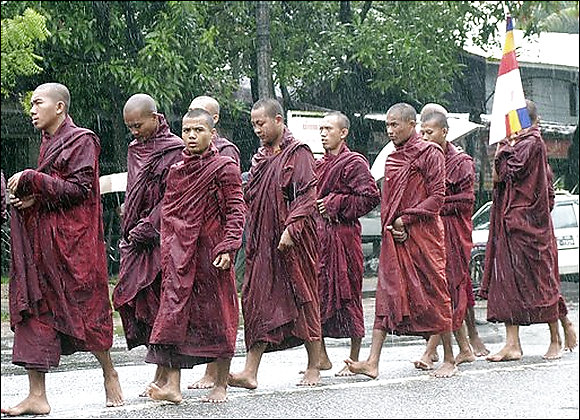It seems that we, who were members of the Architecture, Body, and Performance Seminar, have all (perhaps predictably) focused our attention on issues of body and the state. I appreciated both Omur and Brad’s responses—on the state’s construction of the body and bodily practice, and to the constitutive practices of bodies themselves--and hope I can throw my own thought-hat into the ring.
In our desire to say something meaningful about the “state” we have consistently found ourselves between a rock and a hard place—that is to say, on the one hand we have accepted that it is fallacious to apply generalizing frameworks to “state”, and that we err when we uncritically accept its “thingness” without examining specific contingencies and particular examples; and on the other hand, we seem to continuously find ourselves slipping back into these generalizations as a locus for situating our discussion. As Tom and Brad brought up in class discussion, it often appears that there is incongruence between these totalizing models and the material evidence. Like others in the class have said before me, I think a potential way to avoid this seemingly unavoidable catch-22 is to examine how people comply with, accept, reject, and produce “states” by means of their bodily practices.
Given that we are looking at states in an archaeological context, we are necessarily limited to examining evidence in the material record. Scholars have identified types of material we can use as evidence for the existence of “state”: administrative records (writing), large-scale architecture, central religious institutions, and concentrated urban centers with associated rural areas to name a few. Following Wengrow (2006), another material means to (possibly) identify the presence of state apparatus is increasing standardization and lack of ornamentation on a variety of material types--his “evolution of simplicity”.
While Wengrow has made some very compelling observations about state rule and standardization and the body’s role in the body politic, he too runs into the problem of talking about these practices from a top-down perspective. I think that, following tangentially from Brad’s response, we might do better to look at these material manifestations as negotiations between people. Wengrow touches on this issue when he says, “It is in pursuing access to these sources of social power that individuals become bound, emotionally and psychologically, into institutional lifestyles that offer rewards in return for surrendering some aspect of the self (153)”. Here he addresses the question of motivation for compliance with the dominant state apparatus, but what about the bodily practices that do not survive in the archaeological record?
Recent events in Myanmar (formerly Burma) have made me consider the ephemeral actions of the body. The monks of Myanmar all dress in similar robes and wear very little material ornament (admittedly for religious reasons, not in compliance with the “state”). For the past several weeks they have marched in protest against the current government, and their presence in the streets led thousands of other citizens to join them in their movement. These are bodies in action against the ruling hegemony, a bodily negotiation between those ruling and those who are ruled.
I seem to find myself at this point at the end of all my responses—at an impasse because I look to investigate issues that are immaterial, and very little chance of being attested or surviving in the material record. I suppose the most effective thing to do is to end with a question: how do you think we can examine—in a holistic manner—bodily practices and negotiations within the context of the development and perpetuation of the “state”?

Photo credit: Associated Press
